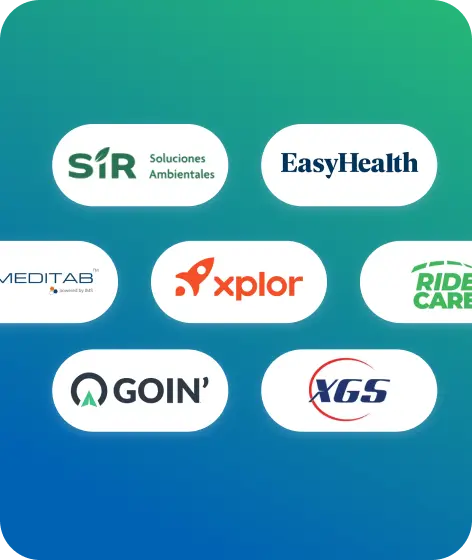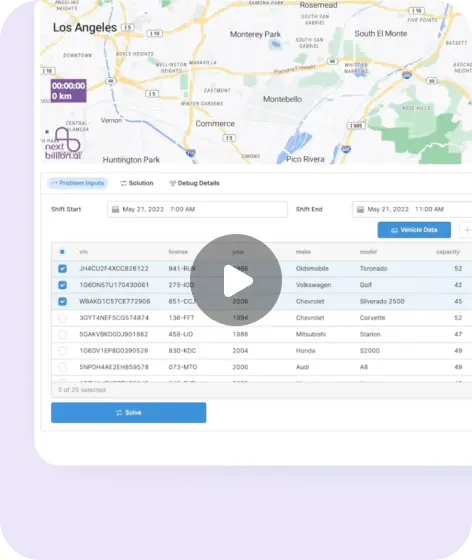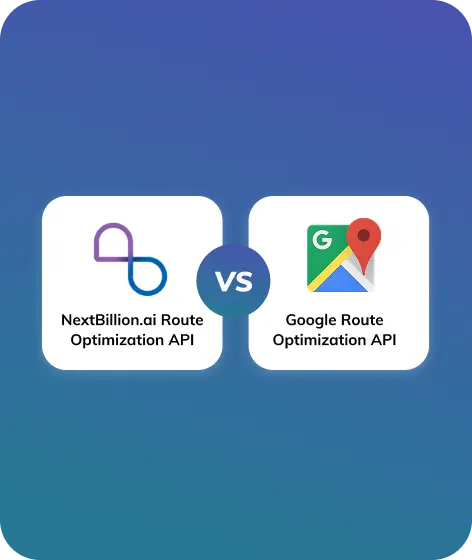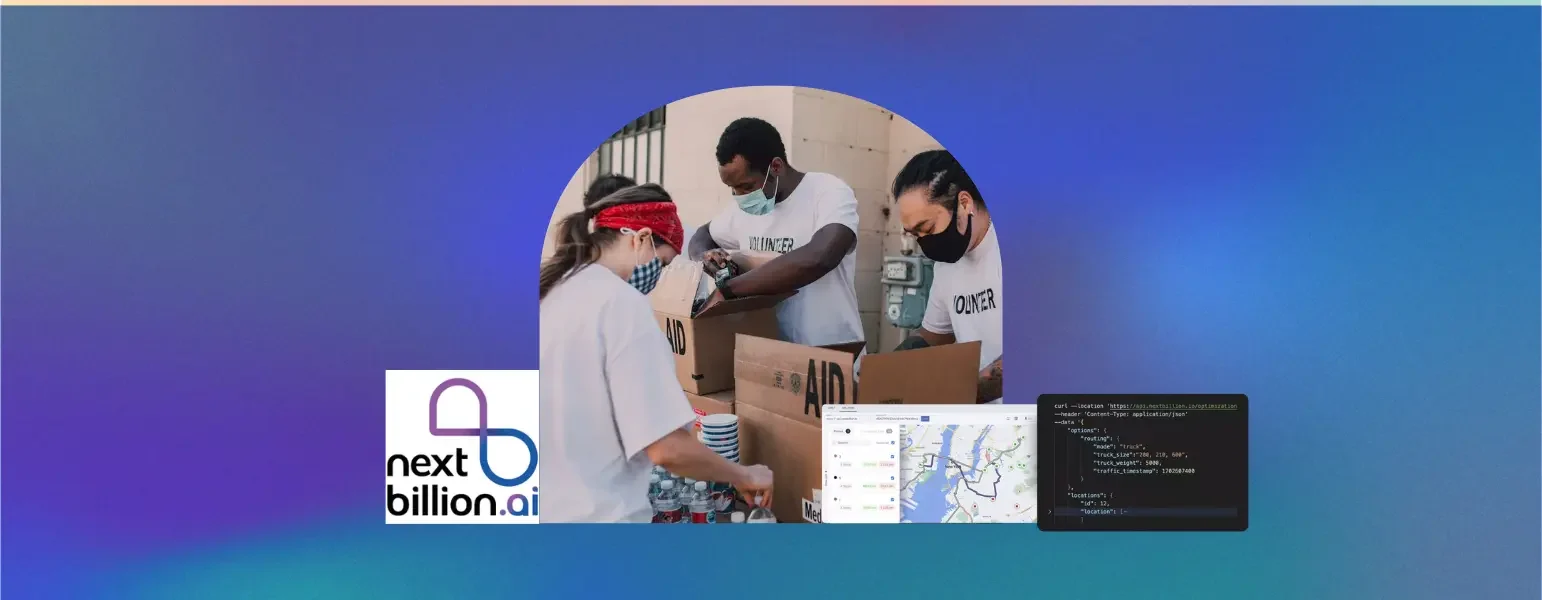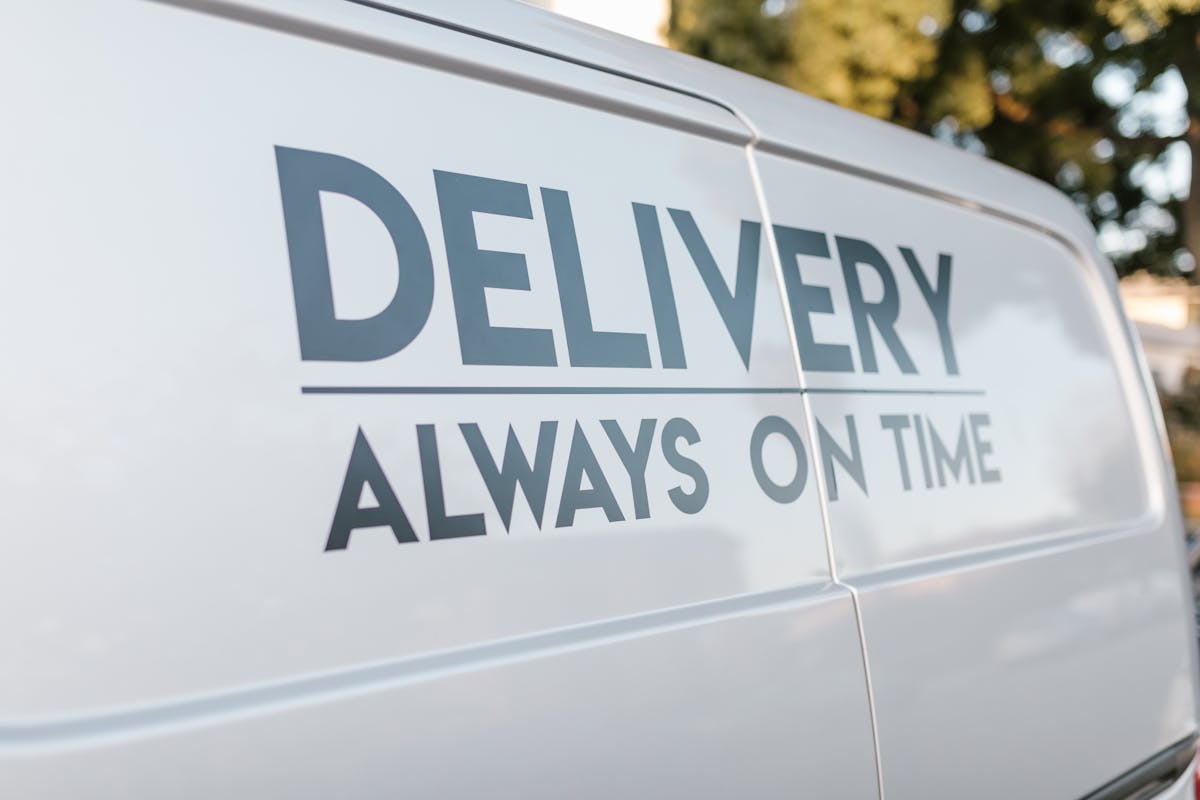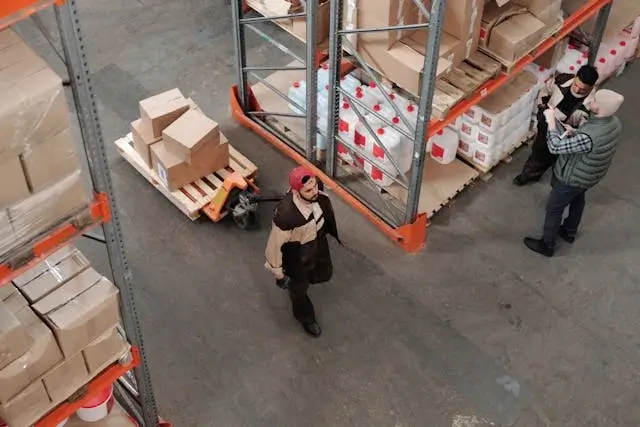
Table of Contents
Are you tired of missed delivery windows, traffic jams, and constant route readjustments?
Managing field services and event deliveries across busy urban areas is challenging, with sudden weather changes, traffic shifts, and last-minute changes complicating your day.
This is where you need assistance from dynamic route optimization. It involves leveraging real-time data and intelligent algorithms to continuously optimize delivery routes, especially for event deliveries across regions. Even according to a 2024 McKinsey report, dynamic routing can reduce delivery delays by up to 30 percent in high-density urban environments.
In this guide, we will walk you through how dynamic route optimization for logistics functions, minus the tech jargon.
Challenges in Event Logistics and Delivery Coordination

Organizing a corporate or private event requires detailed planning and attention because you move several items from one location to another during this time. Whether your business is working for a small gathering or a large conference, effective event logistics is the main resort to make everything run smoothly.
However, there are some challenges that can make the process of event logistics and delivery coordination difficult. Being aware of these challenges and finding solutions to deal with them ensures a successful event across any place. Here’s an overview:
Time-Sensitive Setups and Rigid Schedules
Event deliveries are all about maintaining strict schedules to ensure attendees have everything they want once the program begins. That is why there are strict timelines for staging, audio-visual (AV) setup, catering, and other activities.
However, these activities may be difficult to plan and schedule manually, given the limited timeline for organizing events. Businesses that do not leverage any route optimization software for maintaining schedules may end up missing out on important setups during events. In worst cases, the event may not even be ready or have the required items once the attendees start showing up.
Complex Access Points and Venue Restrictions
Several venues, especially in urban areas, may have restrictions regarding loading docks, access permits, and security protocols. It means delivery businesses get very limited and complex access points for providing their services.
In worst cases, equipment and goods may have to be transferred manually over long distances if freight elevators or ramps are not available in that particular area. This may increase the time and effort needed to transfer logistics, which requires advanced planning and clear communication.
Unpredictable Urban Traffic and Temporary Closures
There is hardly any urban area in this world which is without traffic, and yes, it causes issues with event deliveries several times. That is why events in city centers often face complex traffic conditions throughout the year. This also includes temporary road closure logistics due to parades, protests, or other city construction work.
Logistics teams must monitor real-time traffic updates, have backup routes, and possibly arrange for early morning or late-night deliveries to avoid peak hours. Failure to anticipate these factors can jeopardize the event’s timeline and increase delivery costs.
What Is Dynamic Route Optimization for Event Deliveries?

Dynamic route optimization for logistics is a unique technology that serves as an alternative to inflexible, static routes. Most of these routes cannot keep up with the changing demands of the modern business landscape.
Route optimization for event deliveries is often known for using automated route-optimization algorithms and the most recent data to modify routes. These changes are specifically based on traffic, delivery constraints, and unanticipated events.
Dynamic optimization engines also consider rolling ETAs and driver-specific behaviour patterns, like speed variance or preferred break spots, to calculate not just the route but how that route actually plays out in real-world conditions.
Definition and Core Capabilities
Dynamic route optimization for event deliveries is the process of designing the most cost and time-efficient delivery routes. It involves considering multiple parameters, such as the vehicle type, driver schedule, delivery location, delivery time window, and more.
Route optimization usually works based on real-time routing capabilities that adapt according to the changes in traffic, schedules, and other delays in deliveries. It works on the principle of centralized dispatch that responds to any constraint that may come up during delivery schedules.
Some of the stronger optimization tools also come with constraints layering, where you can apply logic like “avoid school zones during 2 PM to 4 PM” or “deliver AV equipment only after stage scaffolding is confirmed.” These microrules stack inside the algorithm to give planners granular control while keeping routes fluid.
Difference from Standard Routing
Dynamic route optimization’s functionalities are quite different from standard routing. The latter requires you to manually update your static routes so your drivers and technicians can adapt to any last minute alterations throughout the day.
Conversely, dynamic routing requires you to leverage advanced routing algorithms to automatically update your schedule with newly assigned booking processes.
Standard routing has a smaller routing table whereas dynamic route planning allows routers to submit their routing tables to pinpoint delivery availability. Unlike standard routing, dynamic routing uses more complex routing algorithms, such as vector protocols, for making all kinds of route changes.
Another difference between dynamic route optimization and standard routing is the bandwidth usage and computation. Given that standard deliveries already have a predetermined route, they require less bandwidth and compute power. Conversely, dynamic routing deliveries need more bandwidth and computation to create new and unique route probabilities.
Modern systems also make use of GPU-accelerated route computation to handle high-frequency recalculations without latency. This is vital during high-traffic event weekends where delays compound fast. Some platforms offer multi-agent route simulations to test backup plans in parallel before any action is triggered.
Benefits of Dynamic Route Optimization in Event Logistics
Dynamic route optimization for logistics can transform event delivery processes like no other. Businesses can easily utilize real-time data and intelligent algorithms to achieve a new efficiency level in their delivery route planning and execution.
Here are the prominent advantages of dynamic route optimization, especially in the field of event logistics:
On-time Delivery and Setup

Dynamic route optimization constantly updates routes based on real-time data to boost event delivery logistics efficiency. It ensures that your drivers take the most efficient paths to avoid any kind of urban traffic and other delays.
Efficient and smart routing for event vendors during this process allows your drivers to complete more deliveries within the same timeframe. This leads to reduced delays and fewer missed delivery windows. In this way, you also get to reduce the operational costs of your business and maximize the utilization of available resources.
Some systems now factor in setup-time buffers inside the routing logic, so if the AV team needs a 45-minute window before sound check, the route will be padded accordingly, not just calculated based on drive time. Drivers also receive micro-adjustments via mobile, like detouring by 300 metres to avoid double-parked loading bays, which can make the difference between a 3-minute delay and a complete show-stopper.
Lower Operational Costs
In event logistics, the term ‘empty miles’ refers to the distance vehicles usually travel while generating zero revenue for the company but incurring significant transport costs. Dynamic route optimization overcomes this issue by helping you plan the shortest and the most fuel-efficient route for your event deliveries, especially for return journeys. This also allows you to incorporate pickup jobs for fleets returning empty after any event delivery.
Dynamic route optimization is the best technology to help companies of all sizes manage their event deliveries, improve productivity, and save fuel costs. It also helps you add more stops to your event delivery route while providing the customer with a faster delivery.
In fact, some modern DRO engines support something called “reverse-load sequencing,” which builds your return leg around real-time asset availability. So if your LED panel contractor has a cancellation at the next venue, the algorithm reroutes your returning van to pick it up, no calls, no paperwork, just a live update and a rebalanced load.
Better Vendor Coordination
Vendor communication and coordination were never so better than with dynamic route optimization. You can easily connect with AV teams, catering services, and decor providers by leveraging automated routing algorithms. It gives you access to real-time delivery CTAs and route adjustments. This way, vendors can easily align their preparations with incoming event deliveries. Such centralized route planning systems also allow logistics teams to share live updates with vendors through automated notifications.
Newer systems also support logic-based triggers, like if a stage truss arrives early, the system can ping the lighting team and move up their delivery slot automatically. That saves you three calls and avoids the whole “standing around waiting to unload” problem. Some tools even let vendors tag delivery dependencies, so the caterer only gets pinged when the refrigeration unit is confirmed onsite.
Improved Risk Management
Dynamic route optimization involves adjusting travel routes continuously based on real-time data such as weather, traffic conditions, and road closures. This process improves efficiency by ensuring the most accurate and timely routes for event deliveries. It also reduces delays and improves overall travel times.
This real-time adaptability in event logistics allows for quick adjustments without compromising the needs of the attendees. It allows your business to minimize disruptions and maintain all event delivery schedules for improved risk management over time.
Some platforms are going even deeper now, running continuous ETA simulations against changing constraints. If your driver’s ETA drops below an acceptable threshold, say, catering needs to arrive 45 minutes before the guests, an automated alert kicks in to flag dispatch. That means risk gets handled before it ever becomes a crisis. Bonus: some of this predictive logic can even model venue unloading congestion based on past wait-time data.
Key Features of Event-Focused Route Optimization Software
Here is an overview of how route optimization software works well, especially when implemented across event logistics:
Real-time GPS and Traffic Data

Efficient routing and GPS tools meet the needs of all event delivery businesses. Lightweight, flexible, powerful route planning, powered by live vehicle tracking provides your teams and their managers with relevant information required to get more jobs done in the day.
Moreover, real-time tracking through route optimization software ensures that all your delivery routes get adjusted over a period of time. Moreover, the traffic data that you receive can be displayed to the customers as well, who can easily receive updated ETAs, while your technicians are rerouted in the most efficient manner possible.
Several platforms now embed live weather overlays, real-time traffic data layers, and road condition alerts from government APIs or private data streams. This means event delivery teams can easily avoid roadblocks, rain-delayed zones, and even construction detours, without active assistance from any dispatch intervention. Geo-fencing is another critical tool in this regard, which easily triggers location-based check-ins, no-show alerts, or arrival notifications automatically.
Some advanced platforms even support “predictive re-routing,” which kicks in before the slowdown even hits the screen. The system watches traffic patterns in surrounding grids and suggests alternate staging routes ten minutes before congestion spikes. Add to that telemetry-fed brake and idle behaviour from your own fleet, and you are looking at heatmap-level precision without needing a separate dashboard.
Load Sequencing by Priority and Time Slot
Load sequencing refers to the order in which products are specifically loaded onto a transportation unit (TU) so that anyone can unload them in the reverse order in a particular route. Dynamic route optimization provides you with an organized loading sequence to facilitate the unloading of large-scale event transportation units in all given routes.
It enables your event delivery business to offer organized deliveries based on automated event schedules.
Some systems even use RFID-tagged inventory matched with digital load manifests, so if someone loads a high-priority flight case too early, the system flags it before the doors shut. In multi-zone setups, you can tag gear by “Stage Left,” “Green Room,” or “Lobby Install,” and have the system suggest optimal load splits across vans. No more scrambling to unload half the truck just to get to the backdrop.
Mobile Access for Drivers and Event Managers
Dynamic route optimization provides drivers and event managers with real-time updates on routes, traffic conditions, and any changes to their schedules. It helps them use advanced communication tools such as mobile apps or GPS devices for faster event deliveries.
All route optimization apps come with live instructions and update alerts. They help drivers and event managers establish efficient communication channels between managers and dispatchers. It also helps guarantee that all drivers can reach out for assistance if needed.
Better tools now offer push-to-talk integrations for quick voice instructions, not just text. That means when your lighting rig gets reallocated last minute to a different ballroom, drivers get an audio alert while already en route. Apps also sync with wearable devices, so even if someone is in the back of the truck, the update buzzes through the wrist.
Integration with Event Planning Platforms

Dynamic route optimization can integrate with all planning platforms and real-time event delivery management tools. These integrations allow you to pull data from various scheduling systems such as venue delivery windows and event timelines. The software also streamlines these activities with live route planning for better optimization in real-time.
Some enterprise-grade platforms now support bi-directional sync with planning tools like Ungerboeck, Monday.com, or Cvent. That means if your show run-time changes in the event management system, your delivery ETAs and load drop schedules shift automatically. The routing engine does not just adjust, it communicates those changes directly into the system your ops team is already using. Total alignment, no double entry, and no late calls to catch someone up.
Best Route Optimization Tools for Event Logistics
You will come across many dynamic route optimization tools for your event delivery company. However, you must consider only the one tool that resonates with your business needs.
Here is a list of the topmost dynamic route optimization tools that allow automated event setup route planning while offering several other advanced services for event logistics businesses:
Route4Me
Route4Me provides you with a last mile planning software to create reliable, visual routes in seconds. This also involves using various drag-and-drop adjustments for faster event deliveries. The platform offers excellent client services by deploying experts whom you can reach out to using the mobile app support.
PestPac by Workwave
PestPac is specifically built for event delivery companies that want to save on fuel costs by optimizing their route planning services. You can also access customer information to help your event managers and logistics professionals provide better service onsite with the traffic-aware delivery software’s assistance.
Onfleet
Onfleet is a unique software that provides you with the most valuable technician productivity insights, especially if you are in the event logistics business. You can easily track your delivery vehicles in the field and improve fleet operations with this software’s active assistance.
OptimoRoute
This particular software provides you with automated route planning to import thousands of event orders instantly. It allows your managers to access the most efficient routes and schedules along with the drivers.
Tips for Event Managers and Logistics Coordinators
Dynamic route optimization for event delivery businesses is possible only if you know how to implement the process correctly. This requires effective planning on the part of event managers and logistics coordinators which involves relying on some excellent tips to ensure things do not fall out of place. These top route optimization strategies include:
Map Out Delivery Zones in Advance
Event managers and logistics managers must make sure to understand the venue layout and define all staging areas before effective route optimization. Mapping out delivery zones in advance allows them to plan deliveries according to schedules.
Some modern platforms now let you overlay venue blueprints onto route management tools using geo-coordinates. This means staging zones can be geofenced, tagged with delivery rules, like no diesel trucks near indoor halls or only small vans past the east gate, and routed accordingly. You can even build time-sensitive delivery windows tied to setup milestones, like “LED rigging starts at 7 AM, so trussing has to land by 6:15 sharp.”
Prioritize High-impact Deliveries
The managers must analyze which loads are critical and deliver them ahead of other items. Prioritizing high-impact deliveries ensures that they have sufficient time to deliver the rest of the goods to their respective areas.
Some systems now assign delivery risk scores automatically, based on item fragility, setup lead time, or interdependency with other items. If your main screen wall and media server arrive late, the rest of the event falls apart. The platform knows this, so it flags them red and repositions them up the route sequence. You also get advance alerts if something like a flight case with climate-sensitive contents is trending behind schedule, based on micro-telematics from vehicle temperature sensors.
Use Buffer Times for Last-mile Adjustments
Even the most meticulously planned schedules can face unexpected disruptions at times, even in event logistics. This can be related to traffic jams, late vendor arrivals, or even equipment transport glitches. That’s why buffer times from routing software are the key to managing and their respective challenges effectively.
What people miss is that buffers are not just padding, they are dynamic assets. Good routing tools will stretch or compress these buffers in real time. So if the rigging crew is running early but a flatbed with stage flooring is delayed 12 minutes, the system shifts all downstream windows, reroutes drivers where possible, and triggers updates to on-site teams through mobile or wearable notifications. Some tools even offer automated “what-if” simulations that rerun your whole route logic when the first buffer breaks, before you even have to intervene.
Future of Route Optimization in Event Logistics
In 2025, transport route planning and optimization software will become mandatory for event delivery businesses that want to stay competitive. These organizations can easily go ahead with advanced, AI-driven logistics solutions to reduce delivery times, optimize fleet routes, and minimize fuel costs.
The following trends further highlight how dynamic route optimization will bring about a massive transformation in event logistics:
AI-powered Delivery Prediction Models
One of the biggest benefits of route and venue access scheduling software is that it allows you to optimize routes in real-time. This involves unleashing the power of AI-powered prediction models for faster deliveries. The software easily anticipates potential delays based on historic data and continuously analyzes road conditions and vehicle status. These AI-driven systems easily help event delivery companies maximize delivery efficiency and meet tight deadlines.
Some of the smarter tools now train their AI on event-specific patterns, not just city traffic. So if your Saturday venue is next to a stadium, the system already knows to avoid the post-match chaos window. It also factors in vehicle behaviour data, like idle time, brake frequency, or even delivery dwell time to make sure your prediction models are not just smart, but operationally grounded. This is not sci-fi AI. This is “why did we not know this last year?” kind of insight.
Collaboration Between Vendors on Shared Routes
Route optimization software enables vendor collaboration, which allows you to automate your dispatch planning and load building. This also involves tracking vendor commitment and vehicle allocation. The software provides an intuitive and powerful interface to enable goods processing and deliveries for further action.
Advanced platforms allow shared route timelines where AV, lighting, florals, and decor teams can tag their own delivery blocks inside a master run sheet. This means one truck with three vendor loads hits the venue in the right order, and nobody’s gear gets buried under another team’s risers. Some tools also track vendor check-ins and flag non-compliant arrivals so you know exactly who caused a timing jam. Nobody escapes accountability anymore, not even that catering team that swears they were ‘just five minutes away.’
Sustainability Reporting for Large Events
Dynamic route optimization also helps with sustainability reporting for large events. It allows logistics teams to leverage real-time data and intelligent algorithms so that they can minimize idle time, reduce travel distances, and lower fuel consumption. These excellent improvements cut costs and contribute directly to reducing greenhouse gas emissions.
Newer software versions now provide carbon dashboards right inside the route summary, complete with trip-level CO₂ estimates per vehicle. You can export them straight into sustainability reports or ESG filings. Some systems also simulate route variants and give you a “greenest possible path” option alongside your fastest one. And yes, if your fleet has mixed fuel types, the tool can weight routing priority to the EVs by default. Real-world routing, cleaner air, fewer emails.
Conclusion
Dynamic route optimization helps event logistics businesses streamline their operations, cut transportation costs, and improve delivery services. When integrated with field service management software, the automated routing process also reduces delivery time, fuel costs, and other related emissions. If you partner with platforms like NextBillion.ai, its route optimization software also helps you boost fleet and field service efficiency through real-time optimization.
NextBillion.ai offers you with the topmost ride hailing solutions for real-time route optimization. This, in turn, helps your business stay competitive, reduce environmental impact, and improve customer service.
Want to switch to a dynamic routing for logistics solution soon? Visit NextBillion.ai for intuitive route guidance now.
FAQs
Dynamic route optimization helps event logistics companies reduce travel time for deliveries. This reduces fuel consumption because all appointments for event deliveries are categorized under a specific geographical area. It supports drivers and event managers working with logistics businesses to serve more clients without increasing their work hours.
Yes, event logistics software for event planning can easily adjust with road closures and traffic delays. This particular software works based on real-time traffic data. Hence, drivers and event managers are already informed about any closed routes or other blockages so that they can plan alternate routes for faster deliveries.
You may come across several route optimization tools for your event logistics teams. However, we recommend partnering with NextBillion.ai to leverage their efficient route optimization software. It generates the most unique delivery and field service routes suitable for event delivery businesses of all sizes. You can further use its built-in route solver to kickstart your journey without any hassle.
About Author
Bhavisha Bhatia
Bhavisha Bhatia is a Computer Science graduate with a passion for writing technical blogs that make complex technical concepts engaging and easy to understand. She is intrigued by the technological developments shaping the course of the world and the beautiful nature around us.

